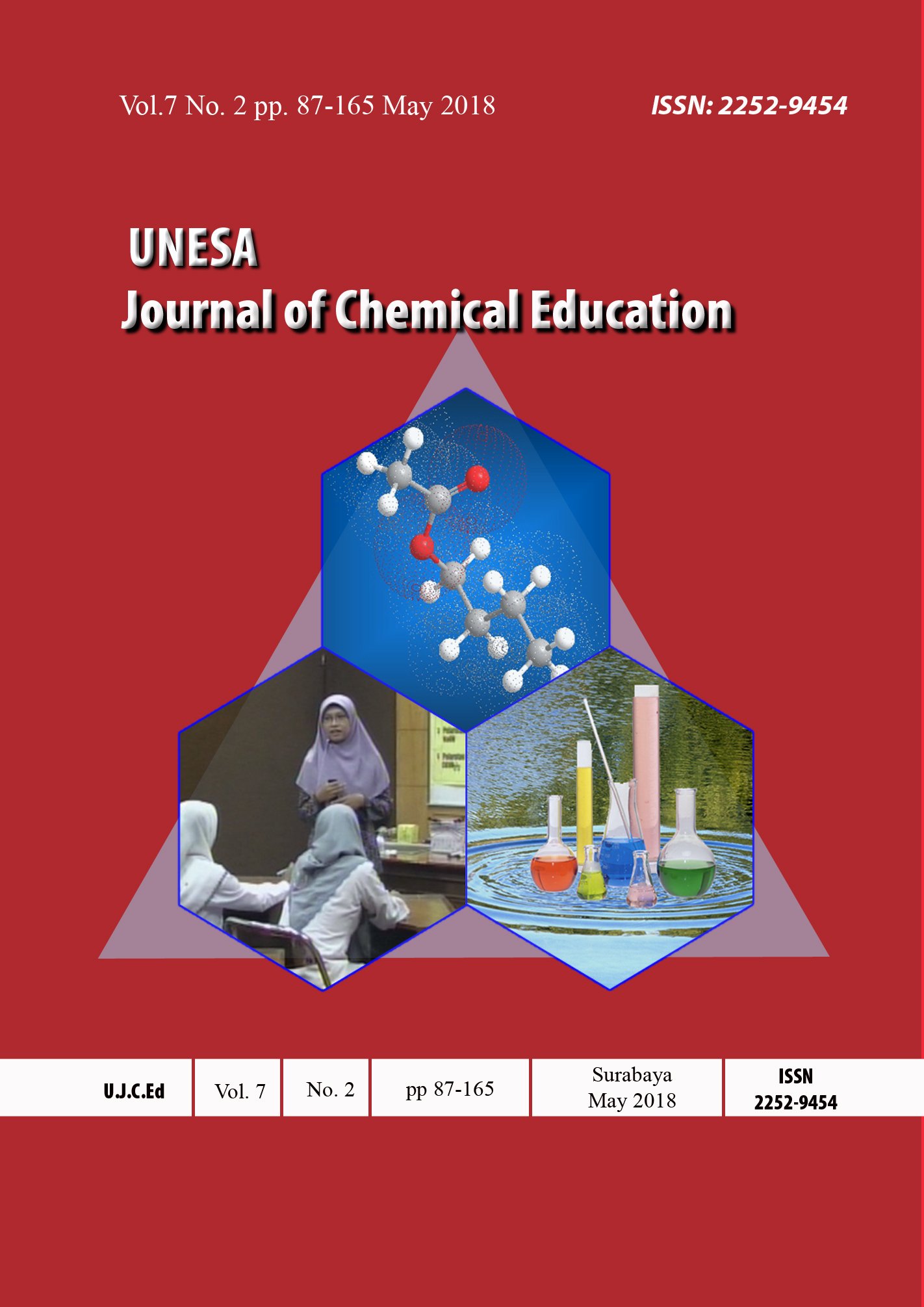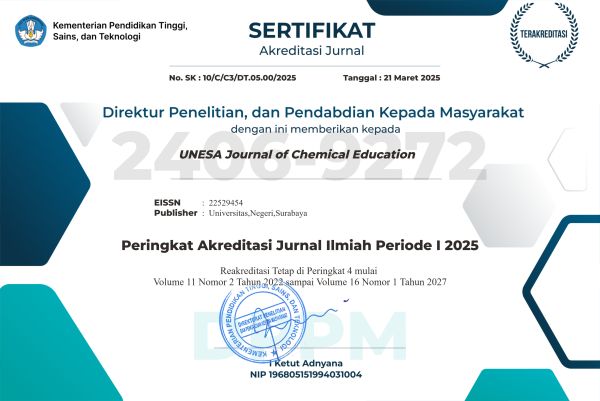IMPLEMENTATION OF COOPERATIVE LEARNING TYPE TWO STAY TWO STRAY (TSTS) ON REACTION RATE MATTER TO TRAIN STUDENT’S SELF EFFICACY GRADE XI
DOI:
https://doi.org/10.26740/ujced.v7n2.p%25pKeywords:
Cooperative Two Stay Two Stray, Self Efficacy, Reaction RateAbstract
The aims of this research are to know implementation of cooperative learning model type Two Stay TwoStray on reaction rate matter, to describe student’s self efficacy and to know student’s reponses on reaction rate matter through the implementation of cooperative learning model type Two Stay Two Stray (TSTS). This research data analyzed by One Group Pretest-Posttest Design. This research was done for three meetings. Instruments that used in this research are implementation observation sheet, questionnaire and observation sheet of student’s self efficacy and student’s responses. It can be concluded that (1) Implementation of cooperative learning type Two Stay Two Stray was 100%; 93.75% and 97.92% in very good category, (2) Student’s self efficacy in level dimension is 76.65 in good category and strength dimension is 74.80 in good category, (3) Student’s responses is ≥61%, so it is in very good category. So it can be concluded that cooperative learning model type Two Stay Two Stray can be used to train student’s self efficacy at XI MIPA 3 SMA Negeri I Manyar.
Downloads
References
Lampiran Permendikbud. 2016. Kurikulum Departemen Pendidikan Nasional, 2003. Undang-Undang Nomor 20 Tahun 2003 Tentang Sistem Pendidikan Nasional. Jakarta: Depdiknas.
Kemendikbud. 2016. Permendikbud No. 20 Tahun 2016 Tentang Standar Kompetensi Lulusan. Jakarta: kementrian Pendidikan Nasional.
Bandura, A. 1997.Self-efficacy: The Exercise of Control. New York: Freeman.
Junaryadi. 2012. Pengembangan Perangkat Pembelajaran Matematika Model Kooperatif Tipe Two Stay Two Stray Dengan Pendekatan Konstruktivisme Untuk Meningkatkan Kemampuan Komunikasi Matematis Siswa. Journal of Primary Educational.
Handayani, Gigih Cahyaning Putri dan Novita, Dian. 2017. Penerapan Model Pembelajaran Kooperatif Tipe Two Stay Two Stray untuk Melatihkan Karakter dan Meningkatkan Hasil Belajar Pada Materi Laju Reaksi di SMA Negeri 1 Krembung Sidoarjo. Unesa Journal of Chemical Education. Vol. 6, No. 1, Tahun 2017.
Guretno. 2015. Pengaruh Model Pembelajaran Kooperatif Teknik Two Stay Two Stray (TSTS) dan Aktivitas Belajar Terhadap Hasil Belajar Siswa Kelas VII Di SMPN 1 Panji Situbondo. Jurnal Penelitian dan Pendidikan IPS (JPPI). Vol. 9, No. 2, pp. 1181-1197, Tahun 2015.
Simanungkalit. 2009. Upaya Meningkatkan Aktivitas dan Hasil Belajar Akuntansi dengan Model Cooperative Learning Tipe Two Stay Two Stray pada StandarKompetensi Persamaan Dasar Akuntansi di Kelas X Ak 5 SMK Negeri 7 Medan Tahun Pelajaran 2009/2010. Medan: UNIMED.
Riduwan. 2012. Metode & Teknik Menyusun Proposal Penelitian. Bandung: Alfabeta.
Sugiyono. 2010. Metode Penelitian Kuantitatif Kualitatif & RND. Bandung: Alfabeta.
Slavin, Robert E. 2005. Cooperative Learning. London: Allymand Bacon.
Adelson, Jill L; Niehaus, Kate; dan Rudasill, Kathleen Moritz. 2012. Self-Efficacy, Intrinsic Motivation, and Academic Outcomes among Latino Middle School Students Participating in an After-School Program. USA: University of Louisville.
Downloads
Published
Issue
Section
License
The license terms of the Creative Commons Attribution-NonCommercial 4.0 International (CC BY-NC 4.0) requires attribution to the original creator, permits non-commercial use, and does not allow for the application of legal or technological restrictions on others' use.
 Abstract views: 70
,
Abstract views: 70
, PDF Downloads: 67
PDF Downloads: 67













